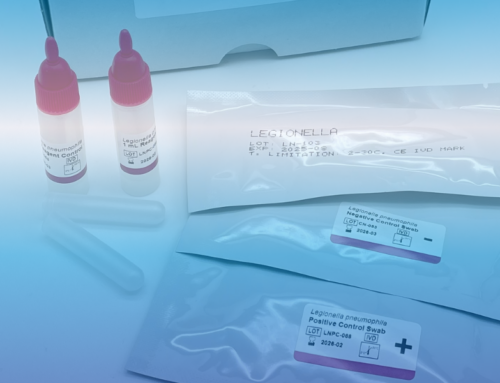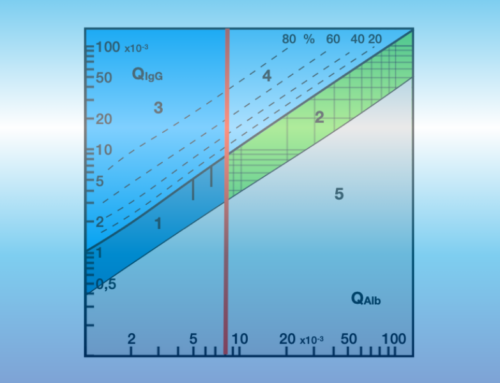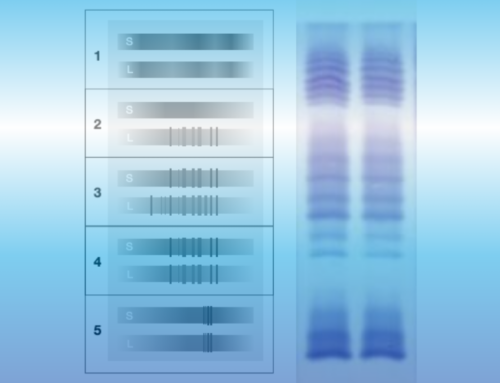A new protein known as κappa-free light chains (κ-FLC) in cerebrospinal fluid (CSF) has been identified as a biomarker for the early prognosis of individual disease progression in multiple sclerosis (MS). The kappa type of FLCs, which circulate predominantly as monomers (22 kDa) in the blood and cerebrospinal fluid, are formed in excess by plasma cells of the immune system and secreted as FLCs.
Until now, the CSF-specific oligoclonal bands (OCB) have been detected in MS due to intrathecal immunoglobulin G (IgG) synthesis. The OCB as the gold standard have a high diagnostic sensitivity and are part of the 2017 McDonald criteria for the guideline-compliant diagnosis of relapsing-remitting MS. The disadvantages are the time-consuming determination, a qualitative result and the dependence on the assessor. In contrast, the intrathecal synthesis of κ-FLC can be determined quickly, easily, cost-effective, returns quantitative results, is rater-independent and has a comparably high diagnostic sensitivity of > 90% as the detection of CSF-specific OCB.
In a study by the Medical University of Innsbruck (Berek at al., 2021), the κ-FLC index was confirmed as an independent marker, calculated from the CSF/serum quotient with reference to albumin CSF/serum quotients (QKFLC/QAlb). In patients with a high κ-FLC index (over 100), the time to a second relapse was only 11 months on average; in patients with a low κ-FLC index (100 or less), a second relapse only occurred after 36 months on average. This new inflammatory marker predicts early MS disease activity and enables individualized treatment.
The combination of the biomarkers κ-FLC and serum neurofilament light (sNfL) as a marker for neuroaxonal damage allows an even more differentiated risk assessment for early MS disease activity. The results of the Innsbruck cohort study (Hegen et al., 2023) show a 98% probability that the next relapse is to be expected within one year in the case of high values for the κ-FLC index and sNfL Z score, while a relapse is unlikely within the next twelve months in the case of normal values for both biomarkers. κ-FLC are intrathecally produced in approximately 90% of MS patients. Further studies are needed to confirm the additive predictive value of κ-FLC index and sNfL Z score and their independent status of each other.
Experts are currently discussing the inclusion of the biomarker κ-FLC in the guidelines for the diagnosis of MS. Hegen et al. (2023) take a clear position on the inclusion of the determination of intrathecal κ-FLC synthesis in the next revision of the MS diagnostic criteria as an additional tool for measuring intrathecal immunoglobulin synthesis. The most informative analysis in MS, although not disease-specific, is the assessment of intrathecal immunoglobulin synthesis, either by qualitative detection of a CSF-specific IgG fraction (by IEF and subsequent immunodetection) or a quantitative CSF-specific κ-FLC fraction (by nephelometry or turbidimetry). OCB should be used for further clarification if κ-FLC synthesis is borderline and vice versa. The combination of both tests seems to be the best option at the moment. Neurologists must consider the results of all tests performed as part of the CSF panel (e.g. leucocyte count, differential cell profile, albumin quotient, intrathecal Ig synthesis, CSF/serum glucose ratio or CSF lactate), which should be interpreted in the context of the clinical and imaging findings.
MS is one of the most common chronic inflammatory neurological diseases of the central nervous system in young adults that can lead to permanent disability. Rapid and reliable diagnosis is important for the clinical management of patients, as disease-modifying therapies are most effective in the early stages of the autoimmune disease. Early prognosis enables personalized therapy.
References:
Kappa-Free Light Chains in CSF Predict Early Multiple Sclerosis Disease Activity. Klaus Berek et al. Neurol Neuroimmunol Neuroinflamm 2021;8:e1005.<em<a/href=”https://doi.org/10.1212/NXI.0000000000001005″>https://doi.org/10.1212/NXI.0000000000001005
Kappa free light chain and neurofilament light independently predict early multiple sclerosis disease activity—a cohort study. Harald Hegen et al. eBioMedicine, Published: April 20, 2023, VOLUME 91, 104573, MAY 2023
<a/href=”https://doi.org/10.1016/j.ebiom.2023.104573″>https://doi.org/10.1016/j.ebiom.2023.104573
Cerebrospinal fluid kappa free light chains for the diagnosis of multiple sclerosis: A consensus statement. Harald Hegen et al. Mult Scler. 2023 Feb;29(2):182-195
https://doi.org/10.1177/1352458522113421
https://register.awmf.org/assets/guidelines/030-141l_S1_Lumbalpunktion_und_Liquordiagnostik_2020-01.pdf
https://www.neurologienetz.de/fachliches/erkrankungen/entzuendliche-erkrankungen-des-zns/multiple-sklerose/diagnosekriterien-nach-mcdonald
https://www.labor-gaertner.de/fileadmin/user_upload/Ravensburg_Gaertner/LaborAktuell_kappaFLC_LMD1026R-11.2020-V2.pdf







